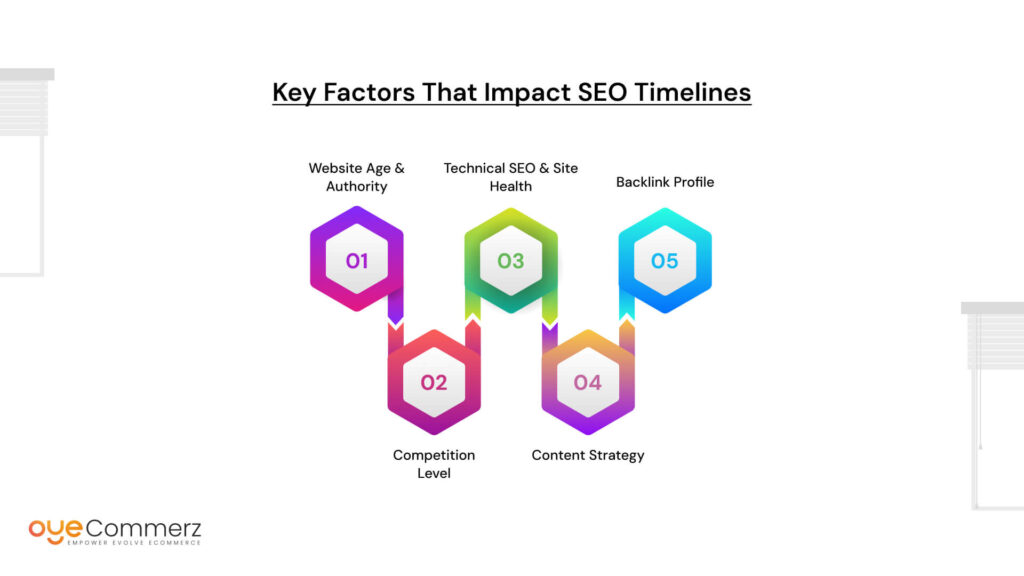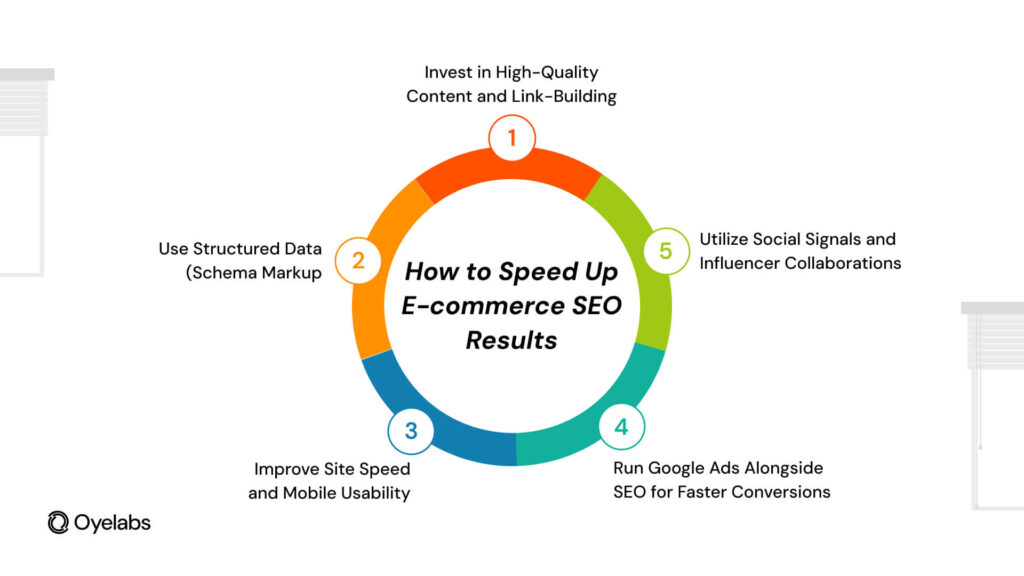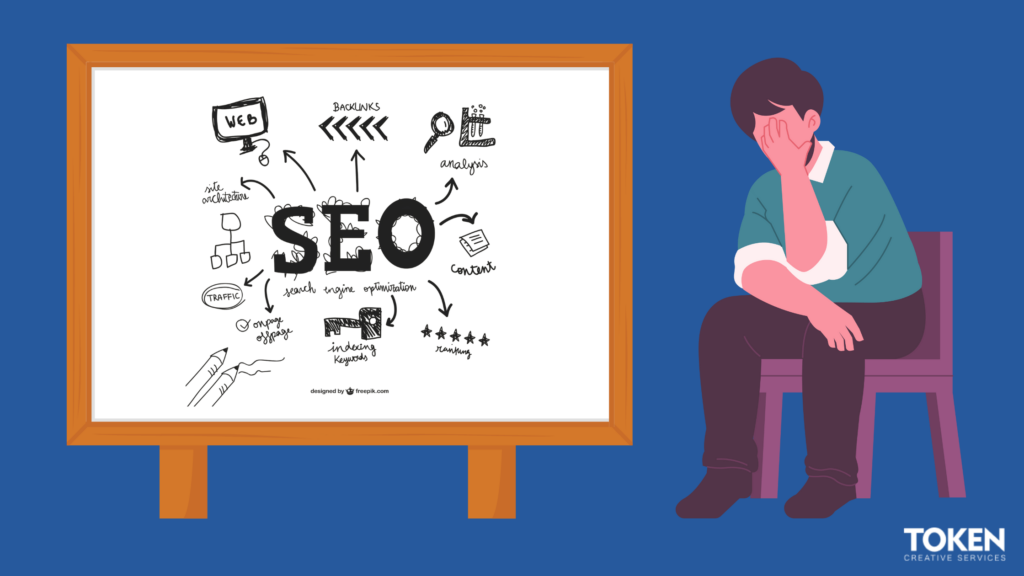How Long Does E-commerce SEO Take? Realistic Timelines & Expectations
If you’re running an online store, you’ve probably heard that SEO is essential for getting more traffic and sales. But how long does it take to see results? Many business owners expect instant rankings, but the truth is—SEO is a long-term game. Unlike paid ads, where you see results almost immediately, SEO takes time to build momentum.
One of the biggest misconceptions about SEO is that you can rank on Google overnight. In reality, it depends on various factors like your website’s age, competition level, content quality, and backlink profile. A brand-new store might take 6-12 months to grow significantly, while an established site with strong authority can improve rankings much faster.
In this article, we’ll break down realistic SEO timelines for eCommerce businesses, explain the key factors influencing ranking speed, and share actionable tips to accelerate your SEO success. Whether you’re just starting or trying to improve your current SEO strategy, this guide will help you set the right expectations and stay on track.
Understanding E-commerce SEO Timelines
E-commerce SEO is different from regular SEO. Unlike a blog or a small business website, an online store has hundreds or thousands of product pages, category pages, and filters. Each of these needs to be optimized, making the process much more complex. Because of this, SEO for an e-commerce site usually takes longer than other types of websites.
One major challenge is product pages. These pages often lack original content because many stores use manufacturer descriptions instead of writing unique ones. Google prefers fresh, valuable content, so if your product descriptions are copied from other websites, it will take longer to rank. Similarly, category pages, essential for e-commerce SEO, require to be optimized with strong keywords, helpful descriptions, and internal linking. Many businesses overlook this, slowing down their SEO progress.
Another reason e-commerce SEO takes time is the level of competition. If you’re selling in a niche with big brands like Amazon, Walmart, or Shopify stores with strong authority, you’re competing against websites that have been around for years. These companies have thousands of backlinks, massive content libraries, and high domain authority. Beating them won’t happen overnight. However, smaller, more specialized stores that target a narrow audience can rank faster by focusing on well-optimized content and targeted keywords.
The time it takes to rank also depends on whether your SEO strategy is focused on local, national, or global reach.
- Local e-commerce SEO (for businesses that sell in specific cities or regions) tends to show results faster because there’s less competition. Optimizing for Google My Business, local keywords, and customer reviews can help speed things up.
- National e-commerce SEO takes longer because you’re competing with a larger number of businesses all over the country. It requires strong content, high-quality backlinks, and a well-structured website.
- Global e-commerce SEO is the most challenging because you’re competing on a large scale. You need to optimize for multiple regions, languages, and currencies, which takes more time and resources.
Because of these complexities, e-commerce SEO requires patience. A solid strategy combined with consistent effort can help your store grow steadily. The key is to focus on long-term results rather than quick fixes. The sooner you start, the sooner you’ll see progress.
Key Factors That Impact SEO Timelines

When it comes to SEO, one of the biggest questions businesses have is, “How long will it take to see results?” The answer isn’t simple because SEO is influenced by many factors. Some websites start ranking within months, while others take a year or more to see significant traffic. Here are five key factors that impact how quickly your SEO efforts show results.
1. Website Age & Authority
New websites often take longer to rank compared to older, more established ones. This is because search engines like Google consider domain age and authority when determining rankings. An older website that has been consistently producing valuable content and earning backlinks has built trust over time. On the other hand, a brand-new site has no history, so Google needs time to evaluate its credibility.
However, newer websites can speed up the process by optimizing their content, focusing on technical SEO, and earning high-quality backlinks. The more effort put into building authority early on, the faster results will come.
2. Competition Level
The level of competition in your niche and the difficulty of your target keywords significantly affect SEO timelines. If you are in a highly competitive industry like finance, law, or healthcare, it can take much longer to rank because many established websites are already competing for the same keywords.
On the other hand, if you are targeting a niche with lower competition, you may see results faster. Conducting thorough keyword research and focusing on long-tail keywords (phrases with three or more words) can help you rank more quickly, as they are often less competitive.
3. Technical SEO & Site Health
A website’s technical foundation plays a huge role in how fast it ranks. Google favors websites that are well-structured, fast-loading, mobile-friendly, and free of technical issues. Common technical factors that impact rankings include:
- Page speed – Slow-loading pages leads to higher bounce rates, which can negatively affect rankings.
- Mobile-friendliness – More than half of internet traffic comes from mobile devices, so Google prioritizes mobile-friendly sites.
- Structured data – Using schema markup helps search engines understand your content better, which can improve visibility in search results.
Regular technical audits and fixes can prevent roadblocks that slow down SEO progress.
4. Content Strategy
SEO is nothing without quality content. Websites that publish well-researched, informative, and engaging content consistently tend to rank faster. Key areas to focus on include:
- Product descriptions – Detailed, unique descriptions help e-commerce sites rank better.
- Blog posts – Regularly publishing valuable blog content improves rankings and attracts organic traffic.
- Category pages – Optimized category pages improve visibility for broad search terms.
Google rewards fresh, relevant, and helpful content. The more you publish, the faster your website builds authority.
5. Backlink Profile
Backlinks—links from other reputable websites to yours—are a strong ranking signal. The more high-quality backlinks you earn, the more authority your site gains in Google’s eyes.
However, not all backlinks are equal. A few high-quality links from authoritative sites can have a bigger impact than hundreds of low-quality ones. Consistently building a natural backlink profile through guest posts, outreach, and partnerships can accelerate your SEO success.
SEO Timeline Breakdown: What to Expect
SEO is a long-term investment, and results don’t happen overnight. Many businesses start their SEO journey expecting immediate success, but the reality is that SEO takes time, effort, and consistency. To help you understand what to expect, here’s a breakdown of the SEO timeline, covering different phases and their key activities.
First 1-3 Months: Laying the Foundation
The first few months of an SEO campaign are all about setting up the right foundation. Think of this stage as preparing the soil before planting seeds. Without proper groundwork, it’s difficult to achieve long-term growth.
Here’s what happens during the first three months:
- Technical SEO Fixes: A website audit is performed to identify technical issues like slow loading speeds, broken links, and mobile usability problems. Fixing these issues ensures that search engines can crawl and index your site efficiently.
- Keyword Research: Finding the right keywords is crucial. SEO experts analyze search trends and user intent to identify high-potential keywords that align with your business goals.
- Competitor Analysis: Understanding what your competitors are doing helps shape your SEO strategy. By analyzing their keywords, content, and backlinks, you can find opportunities to outperform them.
- On-Page Optimization: This includes optimizing title tags, meta descriptions, headings, and internal linking to make sure every page is structured for search engines.
At this stage, you might not see immediate ranking improvements, but these foundational efforts are necessary for long-term SEO success.
3-6 Months: Seeing Initial Improvements
By the three to six-month mark, you’ll start noticing early signs of progress. Your website will become more visible in search results, and you may see some keywords moving up in rankings.
Here’s what happens during this phase:
- Content Creation: Blog posts, product descriptions, and category pages are optimized and published regularly. Search engines love fresh, valuable content, and consistent posting helps improve rankings.
- Backlink Building Begins: Earning high-quality backlinks from authoritative websites helps boost credibility. SEO experts focus on outreach, guest posting, and partnerships to acquire relevant backlinks.
- Initial Ranking Improvements: Some keywords will begin ranking higher, and organic traffic will slowly increase. However, highly competitive keywords may take longer to rank.
- User Engagement Optimization: Metrics like bounce rate, time on site, and click-through rate are analyzed. Enhancing user experience ensures visitors stay longer, signaling to Google that your content is valuable.
During this period, patience is key. While improvements may not be dramatic, the foundation set in the first few months starts to bear fruit.
6-12 Months: Bigger Gains & Traffic Growth
After six months, SEO efforts start showing more noticeable results. The site gains authority, rankings improve significantly, and organic traffic increases.
Here’s what to expect:
- Higher Keyword Rankings: Many of your targeted keywords will begin ranking on the first page, driving more traffic.
- Increased Organic Traffic: As rankings improve, more people will find your website through search engines.
- Enhanced Link Profile: By this time, a steady flow of high-quality backlinks contributes to stronger domain authority.
- Conversion Optimization: More traffic means more opportunities for conversions. SEO strategies shift towards improving landing pages, calls-to-action, and lead-generation efforts.
At this stage, businesses often experience a positive return on investment as SEO starts delivering consistent, quality traffic.
12+ Months: SEO Authority & Long-Term Success
Beyond the one-year mark, SEO transforms into a long-term growth strategy. By now, your website has built a strong presence in search engines, but the work doesn’t stop here.
Here’s what happens in this phase:
- Maintaining & Scaling SEO Efforts: Regular content updates, new keyword targeting, and ongoing technical improvements ensure continuous growth.
- Strengthening Authority: Your website becomes an industry leader, competing with top-ranking competitors.
- Expanding Keyword Reach: With a solid SEO foundation, you can target more competitive and high-volume keywords.
- Long-Term Traffic & Lead Growth: As your authority grows, your website becomes a trusted source, attracting a steady stream of visitors and potential customers.
At this point, SEO becomes a powerful engine driving sustainable business growth. The businesses that stay consistent with their SEO strategy continue to dominate search rankings for years to come.
Related Read: Hiring an Ecommerce SEO Agency vs. Doing It Yourself
Shortcuts vs. Sustainable Growth: Why Patience is Key
Many businesses want fast results from SEO, but the truth is, that shortcuts often lead to failure. Some companies try to game the system using black-hat SEO tactics, hoping to rank quickly. While these tricks may offer temporary gains, they almost always lead to penalties that destroy long-term success.
On the other hand, businesses that focus on sustainable, white-hat SEO build a strong foundation for long-lasting growth. Let’s explore why patience is key and why taking the right approach matters.
The Dark Side of Shortcuts: Black-Hat SEO
Black-hat SEO refers to unethical tactics used to trick search engines into ranking a website higher. These include:
- Keyword Stuffing – Overloading a page with keywords in an unnatural way to manipulate rankings.
- Buying Backlinks – Paying for links from low-quality or irrelevant websites to boost rankings artificially.
- Cloaking – Showing one version of a webpage to search engines and another to users.
- Spamming Comments & Forums – Posting irrelevant links across multiple websites to generate backlinks.
These tactics may work for a short time, but Google’s algorithms are constantly improving. When a website is caught using black-hat methods, it can face severe consequences such as:
- Ranking Drops – A sudden loss of search visibility, which can be difficult to recover from.
- Google Penalties – Manual actions that remove a site from search results entirely.
- Loss of Trust & Credibility – Customers avoid websites that look untrustworthy or spammy.
Instead of focusing on shortcuts, businesses should invest in a sustainable SEO strategy that ensures steady, long-term growth.
The Power of Sustainable Growth: White-Hat SEO
White-hat SEO follows ethical, search-engine-approved practices that drive long-lasting results. These include:
- High-Quality Content – Creating valuable, informative content that answers user questions and solves problems.
- Natural Link Building – Earning backlinks through genuine relationships, guest blogging, and high-quality content.
- User Experience Optimization – Ensuring fast load times, mobile-friendliness, and easy site navigation.
- Consistent Content Updates – Keeping the website fresh and relevant by publishing new blogs, guides, and product pages.
This approach takes time, but the rewards are worth it. Websites that focus on white-hat SEO steadily climb search rankings and maintain their positions without fear of penalties.
How to Speed Up E-commerce SEO Results

SEO takes time, but that doesn’t mean you have to wait forever to see results. While organic growth requires patience, there are smart ways to accelerate the process. If you run an e-commerce business, you need a strategy that boosts visibility, drives traffic, and increases sales—fast. Here’s how to speed up your e-commerce SEO results without cutting corners.
1. Invest in High-Quality Content and Link-Building
Search engines prioritize websites with valuable content. If your product pages only have a few lines of text, they won’t rank well. Instead, create detailed descriptions, answer common customer questions, and include keywords naturally. Adding a blog to your store can also drive organic traffic. Write helpful articles, such as product guides, how-to tips, and industry trends.
At the same time, backlinks from reputable sites help boost your credibility. You can:
- Reach out to bloggers for product reviews.
- Guest posts on industry-related websites.
- Get featured in online publications.
Quality content combined with strong backlinks can significantly improve your search rankings.
2. Use Structured Data (Schema Markup)
Structured data (or schema markup) helps search engines understand your content better. For e-commerce, this means adding special code to your pages to display extra details in search results, such as:
- Product prices
- Star ratings
- Stock availability
- Shipping details
These rich snippets make your listings stand out, increasing click-through rates. Implementing structured data gives you an advantage over competitors who don’t use it.
3. Improve Site Speed and Mobile Usability
A slow website kills sales. If your store takes too long to load, visitors will leave before they even see your products. Google also prioritizes fast-loading sites in search rankings.
To improve speed, you should:
- Compress images to reduce file size.
- Use a content delivery network (CDN) to load pages faster.
- Minimize unnecessary scripts and plugins.
Additionally, mobile-friendliness is essential. With more people shopping on smartphones, your website must be responsive, easy to navigate, and quick to load on all devices.
4. Run Google Ads Alongside SEO for Faster Conversions
SEO is a long-term strategy, but Google Ads can bring quick results. Running paid ads while working on organic rankings ensures immediate traffic and conversions. The key is to target the right keywords. If your store sells “handmade leather wallets,” bidding on those terms in Google Ads can drive buyers to your site while your SEO efforts gain momentum.
A combined approach—using both SEO and PPC—maximizes visibility and helps your brand dominate search results.
5. Utilize Social Signals and Influencer Collaborations
Social media doesn’t directly impact SEO rankings, but it plays a major role in driving traffic. A strong presence on platforms like Instagram, TikTok, and Facebook can increase brand awareness and encourage backlinks from other websites.
Partnering with influencers is another powerful way to gain exposure. When influencers share your products, their audience visits your website, increasing engagement and potential sales. More brand mentions and social shares can indirectly boost your SEO performance.
Also Read: Mobile SEO for Ecommerce: Why Google Prioritizes Mobile-Friendly Stores
Conclusion
SEO is not an overnight success—it takes time, strategy, and patience. A well-optimized website typically starts seeing results within 3-6 months, with significant improvements in 6-12 months. Long-term success comes from consistent effort, quality content, and strong backlinks. Businesses that focus on shortcuts may see temporary gains but risk penalties that can harm their rankings.
The key to winning with SEO is consistency. Regular content updates, technical optimizations, and ethical link-building all contribute to sustainable growth. Instead of chasing quick fixes, invest in strategies that build long-term authority and trust with search engines.
If you’re ready to accelerate your SEO success but don’t know where to start, Token Creative Services can help. Our team specializes in customized SEO strategies designed for long-term results. Whether you need a technical site audit, content strategy, or link-building support, we provide expert guidance to boost your rankings.
Let’s grow your business together. Contact Token CS today for a consultation and start seeing the SEO results you deserve!
Related Articles
Why DIY SEO Fails Most Business Owners (And What to Do Instead)
Freelancer vs. SEO Agency: Who Should You Trust with Your Website?
Let Us help you!
Have a question for our team? Want to learn more about what we offer? Already know what your company needs and just want to have a conversation with us?
Follow us for more helpful content.
Let Us help you!
Have a question for our team? Want to learn more about what we offer? Already know what your company needs and just want to have a conversation with us?

